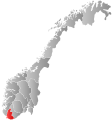Gyland (municipality)
Gyland herred | |
|---|---|
 View of the village church | |
 Vest-Agder within Norway | |
 Gyland within Vest-Agder | |
| Coordinates: 58°25′50″N 06°50′22″E / 58.43056°N 6.83944°ECoordinates: 58°25′50″N 06°50′22″E / 58.43056°N 6.83944°E | |
| Country | Norway |
| County | Vest-Agder |
| District | Lister |
| Established | 1838-1839 |
| Re-established | 1 Jan 1893 |
| Disestablished | 1 Jan 1965 |
| Administrative centre | Gyland |
| Area | |
| • Total | 182 km2 (70 sq mi) |
| *Area at municipal dissolution. | |
| Population (1965) | |
| • Total | 691 |
| • Density | 3.8/km2 (9.8/sq mi) |
| Time zone | UTC+01:00 (CET) |
| • Summer (DST) | UTC+02:00 (CEST) |
| ISO 3166 code | NO-1044 |
| Created as | Formannskapsdistrikt in 1838 |
| Succeeded by | Bakke in 1839 |
| Preceded by | Bakke in 1893 |
| Succeeded by | Flekkefjord in 1965 |
Gyland is a former municipality in the old Vest-Agder county, Norway. The 182-square-kilometre (70 sq mi) municipality was located in the northeastern part of the present-day municipality of Flekkefjord in what is now Agder county. The municipality existed very briefly from 1838 until 1839 and then it was re-created in 1893 and it existed until 1965. The administrative centre was the village of Gyland where Gyland Church is located.[1]
History[]
The parish of Gyland was established as a municipality on 1 January 1838 (see formannskapsdistrikt law), but it was almost immediately merged into neighboring Bakke municipality in the fall of 1839. The Gyland area (population: 1,085) was separated (again) from Bakke municipality on 31 December 1893 to once again form its own municipality. During the 1960s, there were many municipal mergers across Norway due to the work of the Schei Committee. On 1 January 1965, the municipalities of Gyland, Bakke, Hidra, and Nes were merged with the town of Flekkefjord to form a new, larger municipality of Flekkefjord. Prior to the merger, Gyland had a population of 691.[2]
Name[]
The municipality (originally the parish) was named after the old Gyland farm (Old Norse: Gýjuland), where the Gyland Church was originally located. The first element is the old name of the river that flows past the farm (Old Norse: Gýja or Gý) and the last element is land which means "land".[1][3]
Government[]
All municipalities in Norway, including Gyland, are responsible for primary education (through 10th grade), outpatient health services, senior citizen services, unemployment and other social services, zoning, economic development, and municipal roads. The municipality was governed by a municipal council of elected representatives, which in turn elected a mayor.[4]
Municipal council[]
The municipal council (Herredsstyre) of Gyland was made up of representatives that were elected to four year terms. The party breakdown of the final municipal council was as follows:
| Party Name (in Norwegian) | Number of representatives | |
|---|---|---|
| Liberal Party (Venstre) | 2 | |
| Local List(s) (Lokale lister) | 11 | |
| Total number of members: | 13 | |
| Party Name (in Norwegian) | Number of representatives | |
|---|---|---|
| Liberal Party (Venstre) | 2 | |
| Local List(s) (Lokale lister) | 11 | |
| Total number of members: | 13 | |
| Party Name (in Norwegian) | Number of representatives | |
|---|---|---|
| Local List(s) (Lokale lister) | 13 | |
| Total number of members: | 13 | |
| Party Name (in Norwegian) | Number of representatives | |
|---|---|---|
| Labour Party (Arbeiderpartiet) | 1 | |
| Local List(s) (Lokale lister) | 11 | |
| Total number of members: | 12 | |
| Party Name (in Norwegian) | Number of representatives | |
|---|---|---|
| Labour Party (Arbeiderpartiet) | 1 | |
| Local List(s) (Lokale lister) | 11 | |
| Total number of members: | 12 | |
| Party Name (in Norwegian) | Number of representatives | |
|---|---|---|
| Labour Party (Arbeiderpartiet) | 1 | |
| Local List(s) (Lokale lister) | 11 | |
| Total number of members: | 12 | |
| Party Name (in Norwegian) | Number of representatives | |
|---|---|---|
| Labour Party (Arbeiderpartiet) | 3 | |
| Joint List(s) of Non-Socialist Parties (Borgerlige Felleslister) | 9 | |
| Total number of members: | 12 | |
See also[]
References[]
- ^ a b Store norske leksikon. "Gyland" (in Norwegian). Retrieved 6 September 2016.
- ^ Jukvam, Dag (1999). "Historisk oversikt over endringer i kommune- og fylkesinndelingen" (PDF) (in Norwegian). Statistisk sentralbyrå.
- ^ Rygh, Oluf (1912). Norske gaardnavne: Lister og Mandals amt (in Norwegian) (9 ed.). Kristiania, Norge: W. C. Fabritius & sønners bogtrikkeri. p. 339.
- ^ Hansen, Tore, ed. (12 May 2016). "kommunestyre". Store norske leksikon (in Norwegian). Kunnskapsforlaget. Retrieved 21 November 2020.
- ^ "Kommunevalgene 1963" (PDF) (in Norwegian). Oslo: Statistisk sentralbyrå. 1964. Retrieved 21 November 2020.
- ^ "Kommunevalgene og Ordførervalgene 1959" (PDF) (in Norwegian). Oslo: Statistisk sentralbyrå. 1960. Retrieved 21 November 2020.
- ^ "Kommunevalgene og Ordførervalgene 1955" (PDF) (in Norwegian). Oslo: Statistisk sentralbyrå. 1957. Retrieved 21 November 2020.
- ^ "Kommunevalgene og Ordførervalgene 1951" (PDF) (in Norwegian). Oslo: Statistisk sentralbyrå. 1952. Retrieved 21 November 2020.
- ^ "Kommunevalgene og Ordførervalgene 1947" (PDF) (in Norwegian). Oslo: Statistisk sentralbyrå. 1948. Retrieved 21 November 2020.
- ^ "Kommunevalgene og Ordførervalgene 1945" (PDF) (in Norwegian). Oslo: Statistisk sentralbyrå. 1947. Retrieved 21 November 2020.
- ^ "Kommunevalgene og Ordførervalgene 1937" (PDF) (in Norwegian). Oslo: Statistisk sentralbyrå. 1938. Retrieved 21 November 2020.
- Flekkefjord
- Former municipalities of Norway
- 1838 establishments in Norway
- 1839 disestablishments in Norway
- 1893 establishments in Norway
- 1964 disestablishments in Norway


